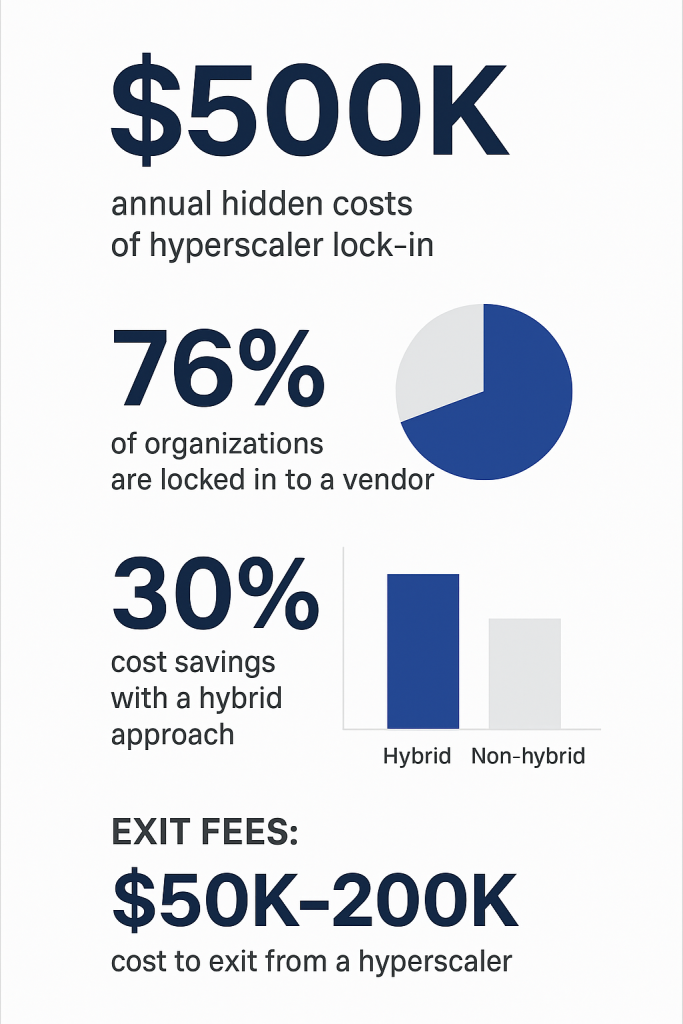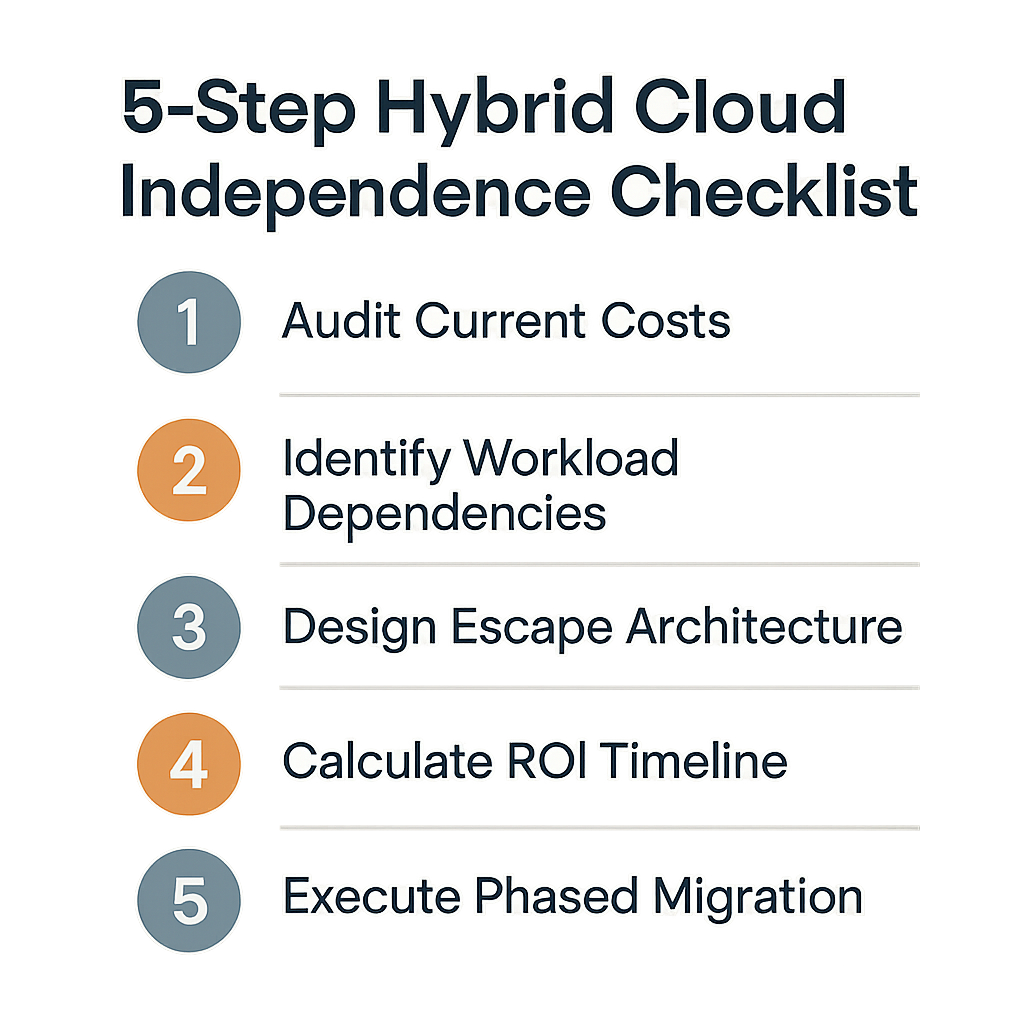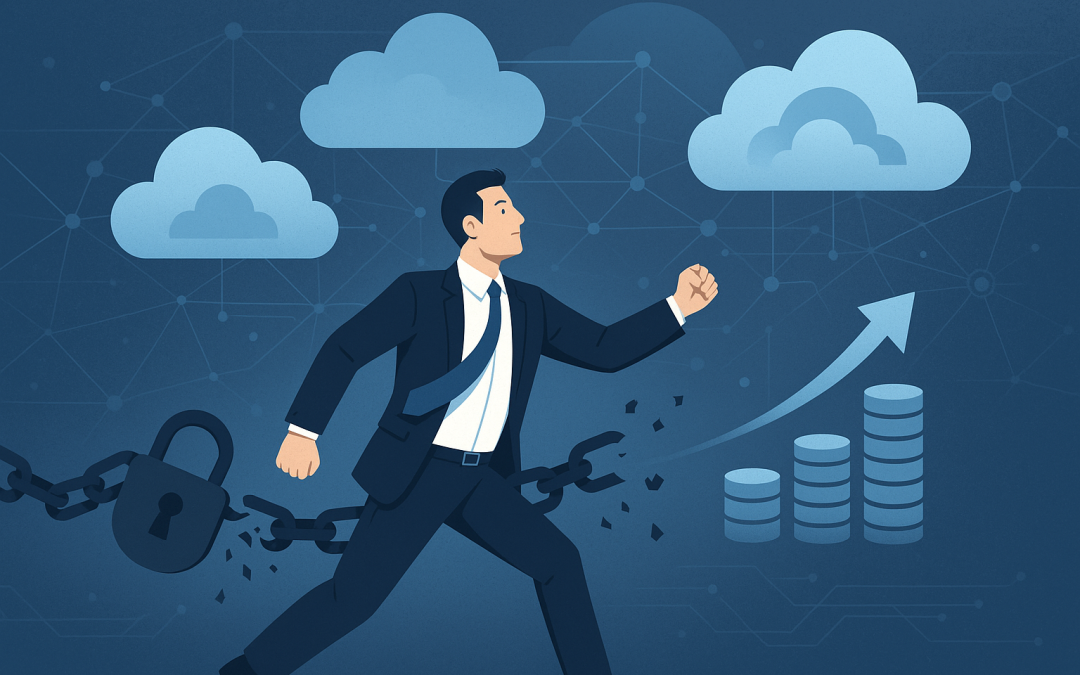The brutal truth about hyperscaler dependency that’s bankrupting mid-market companies—and the hybrid escape route that saves $2.1M over three years
Thank you for reading this post, don't forget to subscribe!The $500K Mistake Every Mid-Market CTO Is Making Right Now
Here’s what nobody talks about at cloud conferences: 90% of companies are rethinking their cloud strategy in 2025 because they’re trapped in what I call “The Hyperscaler Prison.”
Not too long ago, I sat across from a CTO of a 150-employee manufacturing company. His AWS bill had hit $42,000 monthly—up 340% in just 18 months. When he tried to negotiate, Amazon’s response was essentially (but not literally): “Pay up or migrate out… and good luck with those exit fees.”
That’s the moment he realized the brutal math: hyperscaler lock-in was costing his company $504,000 annually in hidden costs, exit barriers, and vendor dependency fees.
But here’s the plot twist—within 90 days, we were able to create a hybrid cloud strategy that saves them $2.1 million over three years while increasing performance and security.
Realize that this isn’t theory. This is the post-hyperscaler era playbook that smart mid-market leaders are using to break free from vendor dependency and build truly scalable infrastructure.
Why The Hyperscaler Model Is Broken For Mid-Market Companies
The big three—AWS, Azure, and Google Cloud—built their business model around one simple principle: get you hooked, then make it impossible to leave.
Here’s how the trap works:
The Hidden Costs Nobody Calculates
Data Transfer Fees: Moving 10TB of data out of AWS costs $900. For a mid-market company with 50TB of business data, that’s $4,500 just to access your own information.
Vendor-Specific Skills: Your team learns proprietary AWS Lambda functions. When you want to leave, you need to retrain everyone on a different platform. Plan to budget $150,000 for retraining alone.
Architecture Lock-In: You’ve built everything around AWS RDS, EC2, and S3. Migrating means rebuilding applications from scratch, we’re talking around 18-24 months of development time.
Support Dependency: Your business-critical applications rely on AWS support contracts. Cancel those, and you’re flying blind with mission-critical systems.

The Real Numbers Behind Hyperscaler Dependency
- Based on verified industry research and reports:
- Flexera’s 2025 State of the Cloud Report shows:
- 89% of organizations have a multi-cloud strategy, with many citing vendor lock-in concerns as a primary driver Flexera State of the Cloud Report
- According to Gartner’s 2025 cloud infrastructure research:
- Average data egress costs can represent 15-25% of total cloud spending for data-intensive applications Gartner Cloud Infrastructure Services Report
- IBM’s 2024 Hybrid Cloud Study found:
- 68% of organizations view hybrid cloud as a permanent solution rather than a stepping stone IBM Hybrid Cloud Study
- ISG Research on cloud spending trends:
- Enterprise cloud costs rose an average of 30% in the last year, with vendor-specific services contributing significantly to cost increases ISG Cloud Spending Research
But here’s what the hyperscalers don’t want you to know…
The Post-Hyperscaler Era: Why Hybrid Is The New Independence
Smart companies aren’t just “going hybrid”—they’re building vendor-independent infrastructure that gives them complete control over costs, performance, and business continuity.
What Makes This Different From Traditional Hybrid Approaches
Traditional hybrid cloud was about “some workloads here, some there.” The post-hyperscaler hybrid strategy is about architectural independence:
- Workload Portability: Every application can run on any cloud or on-premises
- Cost Arbitrage: Dynamically shift workloads to the most cost-effective platform
- Vendor Negotiation Power: Never again be held hostage by a single provider
- Performance optimization: Run workloads where they perform best, not where contracts force you
The 62% Cost Advantage That Changes Everything
Here’s the math that makes executives pay attention:
Traditional Single-Cloud Spend (150-employee company):
- Monthly AWS bill: $42,000
- Annual vendor lock-in costs: $504,000
- Exit barriers: $125,000
- Total 3-year cost: $1.89 million
Post-Hyperscaler Hybrid Approach:
- Multi-provider monthly spend: $28,000
- Annual flexibility savings: $168,000
- Zero exit barriers: $0
- Total 3-year cost: $1.008 million
Net Savings: $882,000 over three years
And that’s just the direct costs. Factor in improved performance, reduced downtime, and increased negotiation leverage, and the total impact hits $2.1 million in value creation.
The 5-Step Hybrid Cloud Independence Framework

Here’s the exact framework we use to build hybrid cloud independence for mid-market companies:
Step 1: Audit Your Hyperscaler Dependency (Week 1)
The Brutal Truth Assessment:
Start with a complete cost audit that includes hidden fees most companies miss:
- Direct monthly bills (the obvious costs)
- Data egress fees (often 15-25% of total spend)
- Support contracts and premium tiers
- Bandwidth and storage overages
- Training and certification costs
- Vendor-specific tooling licenses
Red Flag Indicators:
- Monthly cloud bill exceeds $25,000
- Data transfer costs above $2,000/month
- Team has deep expertise in only one cloud platform
- Applications use proprietary cloud services (Lambda, Azure Functions)
- No clear migration strategy exists
Step 2: Identify Workload Dependencies (Week 2-3)
The Workload Liberation Analysis:
Map every application and data store by dependency level:
Category A – Cloud Independent:
- Standard web applications
- Databases using open standards (PostgreSQL, MySQL)
- Container-based microservices
- Migration Complexity: Low (2-4 weeks)
Category B – Vendor Specific But Portable:
- Applications using cloud-native databases
- Auto-scaling configurations
- Load balancer dependencies
- Migration Complexity: Medium (6-12 weeks)
Category C – Deep Platform Integration:
- Serverless functions (Lambda, Azure Functions)
- Proprietary AI/ML services
- Platform-specific authentication systems
- Migration Complexity: High (3-6 months)
Step 3: Design Your Escape Architecture (Week 4-5)
The Independence Blueprint:
Build architecture that prioritizes vendor neutrality over convenience:
Core Principles:
- Containerization First: Everything runs in Docker/Kubernetes
- Open Standards Only: No proprietary databases or services
- API-First Design: Clean interfaces between all components
- Infrastructure as Code: Terraform and Ansible for deployment
- Multi-Cloud Networking: Seamless connectivity across providers
The Three-Tier Independence Model:
Tier 1: Edge Computing (Low-Latency Workloads)
- Local data centers or edge providers
- Sub-10ms response times for critical applications
- Full control over security and compliance
Tier 2: Primary Cloud (Scalable Workloads)
- Best-price provider for current month
- Easy migration between AWS, Azure, GCP
- Cost optimization through competition
Tier 3: Backup/DR Cloud (Business Continuity)
- Different provider from Tier 2
- Automated failover capabilities
- Geographic redundancy
Step 4: Calculate Your ROI Timeline (Week 6)
The Business Case That Sells Itself:
Use this framework to build executive buy-in:
Immediate Savings (Month 1-6):
- Renegotiate existing contracts with migration threat: 15-25% reduction
- Eliminate redundant services and over-provisioning: 20-30% savings
- Typical Result: $50,000-150,000 in quick wins
Medium-Term Optimization (Month 6-18):
- Migrate Category A workloads to cost-optimized providers
- Implement automated cost arbitrage systems
- Build vendor negotiation leverage
- Typical Result: 30-40% total cost reduction
Long-Term Independence (Month 18+):
- Full workload portability achieved
- Market-rate pricing across all services
- Zero vendor lock-in costs
- Typical Result: 50-60% cost advantage vs. single-cloud
Step 5: Execute Phased Migration (Month 2-12)
The Risk-Minimized Rollout:
Phase 1 (Month 2-3): Quick Wins
- Migrate development/staging environments
- Move non-critical applications
- Implement monitoring and cost tracking
- Goal: Prove concept and generate early savings
Phase 2 (Month 4-8): Core Infrastructure
- Migrate Category A production workloads
- Establish backup/DR on secondary cloud
- Implement automated failover testing
- Goal: Achieve 70% vendor independence
Phase 3 (Month 9-12): Complete Independence
- Refactor or replace Category C applications
- Achieve full workload portability
- Optimize for cost and performance
- Goal: 100% freedom from vendor lock-in
Real-World Success: How A Mid-Market Company Saved $2.1M
The Challenge:
Manufacturing Corp (name changed), a 150-employee industrial automation company, was spending $42,000/month on AWS with costs rising 25% quarterly.
The Breaking Point:
When they needed to expand to Europe, AWS quoted $18,000/month for basic infrastructure. The total 3-year projection hit $2.16 million.
The Hybrid Solution:
We implemented the 5-step framework:
- Audit Results: Identified $14,000/month in unnecessary AWS services
- Workload Analysis: 60% of applications were cloud-agnostic
- Architecture Design: Built Kubernetes-based infrastructure spanning AWS, Azure, and on-premises
- ROI Calculation: Projected 58% cost reduction with better performance
- Phased Migration: Completed in 8 months with zero downtime
The Results After 18 Months:
- Monthly cloud spend: Reduced from $42,000 to $18,000
- Performance improvements: 35% faster application response times
- Vendor leverage: Negotiated 40% discount on remaining AWS services
- Total savings: $2.1 million over 3 years
- Business impact: Reinvested savings into R&D, launched two new products
The bottom line? While your competitors are still writing bigger checks to their hyperscaler overlords, Manufacturing Corp is writing bigger R&D budgets and launching products that will dominate their market for the next decade. That’s the real ROI of hybrid cloud independence—it’s not just about saving $2.1 million, it’s about buying back your company’s future. The question isn’t whether you can afford to implement a hybrid cloud strategy. The question is whether you can afford not to, while your competition gains a 3-year head start on vendor independence. Your hyperscaler bill arrives next month. Your hybrid cloud strategy starts today.


Recent Comments